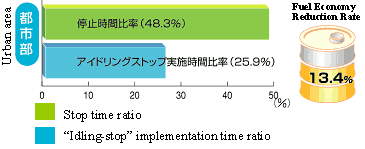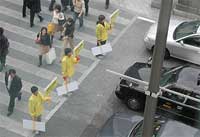|
- Idle-free driving can improve fuel economy by approx.10%. - Partial subsidy for the purchase of cars equipped with the "idling-stop" system was introduced in FY2003. - Promotion campaigns for the "idling-stop" systems are held in the forms of PR events, etc. |
| Effects of the driving experiments by "idling-stop" cars |
Results of "The Idling-Stop 2002 Caravan throughout Japan"

| Nationwide (3719km) 5.8% on average Or 13.4% in city areas [The stop idling-stop implementation time ratio in city area] |
| PR activities |
| In October 2003, an event for "idling-stop" experiments took place at Tokyo's Ginza and Osaka's Shinsaibashi traffic lights. |




